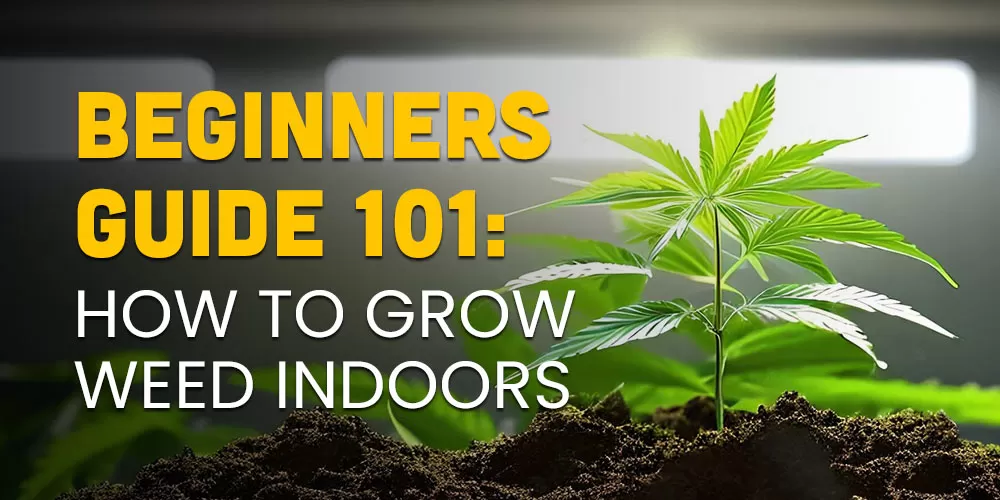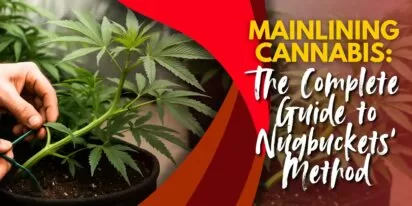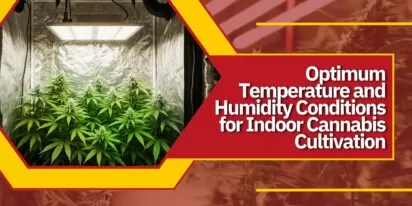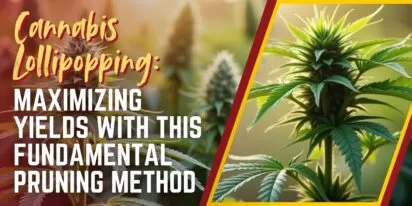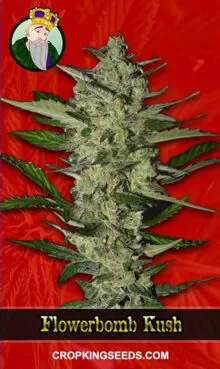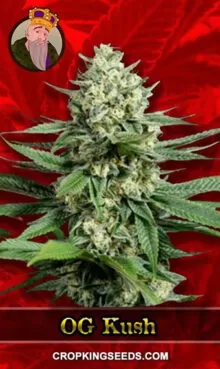Table of Contents
ToggleGrowing weed indoors has witnessed a surge in popularity, with numerous states and countries legalizing its use for medicinal and recreational purposes. Engaging in indoor weed growing can be an enriching experience, offering a means of obtaining medicine or a fulfilling pastime. However, growing marijuana indoors demands a degree of expertise and readiness to achieve success. In this beginner’s guide, we shall explore the fundamentals of growing cannabis indoors, from selecting a suitable location and equipment to preparing the soil, planting, and harvesting. We shall also address common challenges and how to prevent or treat them. Whether you are a beginner or an experienced cultivator, this guide guarantees you the knowledge and resources to nurture healthy and potent cannabis plants.
What are the Benefits of Indoor Marijuana Growing?
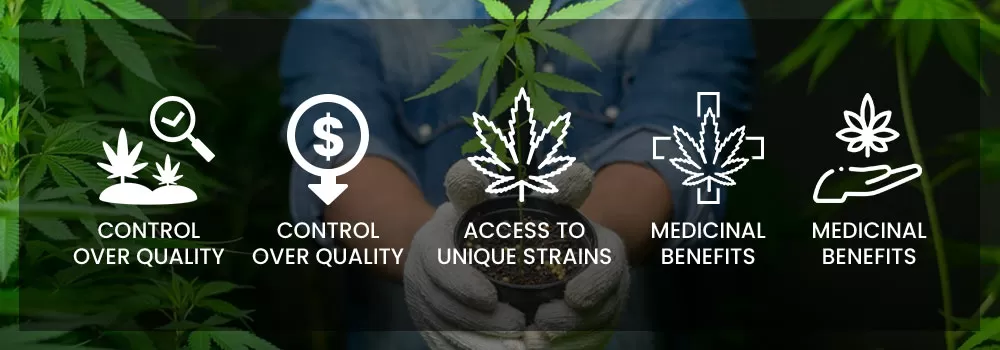
The cultivation of cannabis bears significance as it permits the regulated development and manufacture of superior-grade cannabis plants. This venture involves thorough strain selection, suitable nutrients and environment for the plant’s flourishing, and a timely harvest to guarantee maximal potency and flavor. The advantages of growing cannabis encompass the following:
Control over quality: When you grow cannabis indoors, you have complete control over the growing conditions, ensuring your plants are free of harmful chemicals or contaminants.
Cost savings: Growing cannabis can be significantly cheaper than buying it from a dispensary or dealer, especially if you use energy-efficient methods and grow multiple plants.
Access to unique strains: There are thousands of cannabis strains available, and many are not widely available in dispensaries. By growing your own, you can experiment with different strains and find the ones that work best for your needs.
Medicinal benefits: Cannabis has been shown to have a range of medicinal benefits, including pain relief, anxiety reduction, and appetite stimulation. Growing your own can ensure a steady supply of high-quality medicine.
Sustainability: Growing your cannabis can be a sustainable option. You can use organic growing methods and reduce your carbon footprint by avoiding transportation and packaging associated with buying from a dispensary.
What are the Different Types of Cannabis Plants?
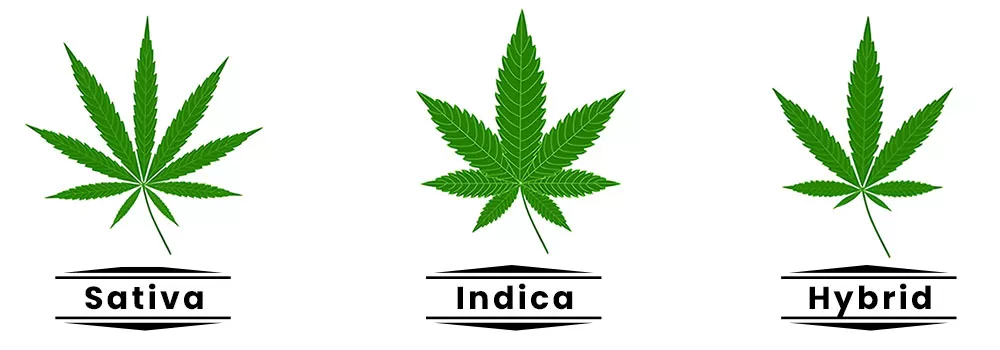
A diverse array of cannabis plants exists due to their purposeful breeding over time, aimed at enhancing distinct attributes such as potency, flavor, and growth characteristics. This attempt has yielded various cannabis plants, each with unique properties and effects. Therefore, selecting the appropriate strains that match one’s preferences is crucial.
Tutorial on how to choose the best strain
Here is a brief overview of each type of cannabis plant:
Sativa: Sativa plants typically thrive in warm, tropical climates and have extended flowering than Indica plants. Renowned for their stimulating and invigorating properties, they are highly sought-after among individuals seeking a cerebral high that bolsters creativity and focus. Sativa plants generally exhibit a higher ratio of THC to CBD, resulting in a more potent psychoactive impact. The typical effects of Sativa strains encompass a sense of euphoria, heightened senses, increased energy, and a general sense of well-being. Due to their potential to encourage productivity and creativity, Sativa strains are frequently utilized during daytime activities.
Indica: Indica plants typically flourish in cooler climates and have shorter flowering than Sativa plants. Appreciated for their tranquil and calming traits, they are highly favored among individuals seeking to alleviate stress and unwind. Indica strains often exhibit a higher ratio of CBD-to-THC, leading to a more pronounced physical effect. Commonly associated effects of Indica strains include relaxation, pain relief, sedation, and appetite stimulation. Indica strains are frequently utilized in the evening or at night due to their potential to facilitate restful sleep.
Hybrid: Hybrid plants are a cross between Sativa and Indica strains, combining the effects of both. There are countless hybrid strains available, each with its unique characteristics. Hybrid strains can be either Sativa-dominant or Indica-dominant, depending on the parent plants used in the crossbreeding process. Some common effects of hybrid strains include a balance of cerebral and physical effects, making them ideal for people who want the best of both worlds.
Feminized: Feminized plants are selectively bred to exclusively yield female plants that bear the highly potent buds utilized for medicinal and recreational purposes, thereby eliminating the need to detect and remove male plants lacking such attributes. These plants are highly preferred among growers who seek to optimize their harvest as they generally boast a higher yield than conventional cannabis plants. Additionally, feminized plants exhibit a more uniform growth pattern, making them easier to manage and cultivate.
Autoflower: Autoflowering plants are a distinctive category of cannabis plant that undergoes an automatic transition from vegetative growth to flowering without any lighting adjustments. This unique feature renders them exceptionally convenient and ideal for novice growers. Autoflowering plants typically exhibit a smaller stature than conventional cannabis plants, making them appropriate for cultivation in little indoor spaces or limited outdoor gardens. Furthermore, they boast a shorter flowering period than traditional cannabis plants, facilitating multiple harvests during a single growing season.
Would you like to know? The difference between Autoflower and Photoperiod Seeds
Seeds are not the only way of growing cannabis there is another way that includes a whole new level of expertise, and we are going to discuss the difference between this technique, known as cloning, and growing from traditional seeds.
Know What You Need: Seeds vs. Clones
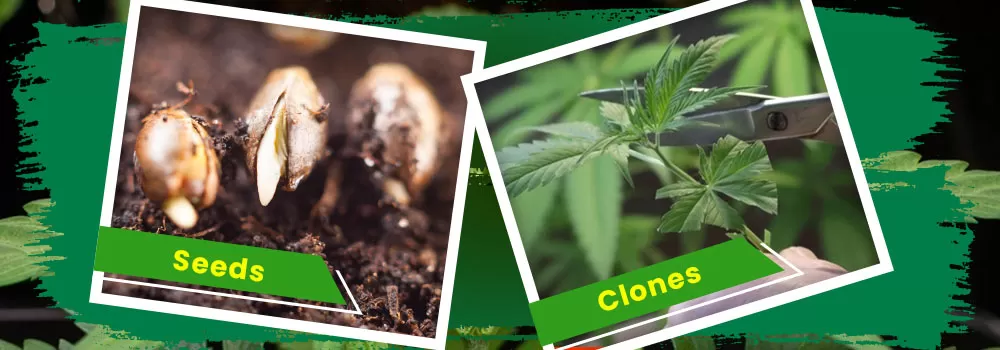
Seeds
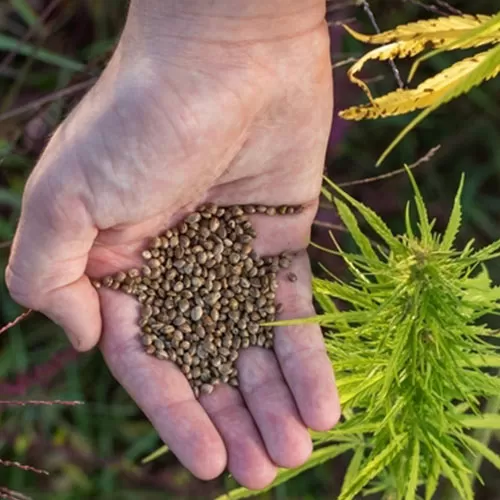
Starting with seeds is a popular way for many people to begin growing cannabis, as they can be easily purchased online and delivered discreetly worldwide. However, ensuring that the seeds purchased are viable and healthy is crucial. Viable cannabis seeds are typically hard and dark-colored. In contrast, small and white seeds are often immature and will not germinate.
It’s recommended that healthy seeds are stored in a cool and dry place away from light, such as in a fridge, until ready for use. Seeds can remain viable for up to five years or longer with proper storage. However, it’s not recommended to freeze the seeds as it may damage them.
Good seeds can sometimes be found in the marijuana purchased, referred to as “bagseed,” which can be used to start growing. However, using bagseeds has its downsides, as about half of the seeds will end up being male, and only half will be female, which are the ones that produce the buds. Moreover, growers need to figure out what to expect regarding how the plant will tend to grow.
Nonetheless, many growers start growing cannabis with their collected bagseed, an excellent way to begin growing. Some growers have had great results with bagseeds, while others end up with plants different from the buds in which they were found.
It’s worth noting that the strain and genetics of the seeds play a significant role in determining the quality of the buds that will be produced. Therefore, purchasing high-quality seeds from reputable breeders can significantly increase the chances of obtaining high-quality buds.
Clones
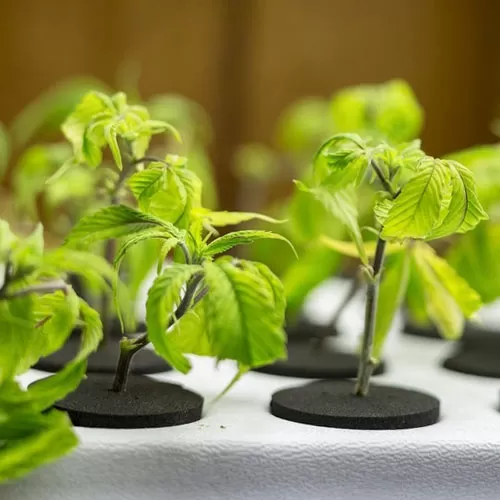
Clones are identical copies of another plant and are helpful for growers who want to know exactly what to expect from their plant. Clones can save time compared to starting with seeds because they already have a head start on growth.
To obtain cannabis clones, you need to know someone with cannabis plants since it’s impossible to order them online consistently. However, anyone can start growing from seeds.
Clones have the same genetics as their parent plant, including gender, which guarantees the gender of the plant. You can also clone female plants to make more copies without worrying about sexing your plants or creating seeds.
If starting with a clone, treat it gently for the first day or two and keep it moist and under gentle light until it develops roots. A humid cloner or misting the plant a few times daily can help with rooting. Once the clone has roots, you can put it in its new home with grow lights further away than normal.
Want to start cloning here is the way to go!
How to Grow Cannabis Indoors
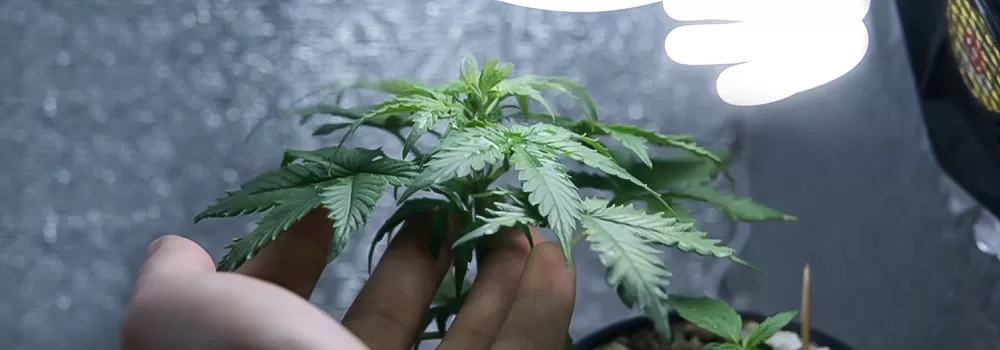
Growing cannabis indoors has become increasingly popular due to its many benefits. It allows for greater environmental control, resulting in higher yields and better-quality buds. Indoor growing also provides greater privacy and security compared to outdoor growing. However, it requires a bit more setup and investment compared to growing outdoors, but with the right knowledge and equipment, it can be a rewarding and enjoyable experience. And here, we are going to discuss what you are going to need if you plan to go indoors we will start with choosing the right location.
Choosing a location
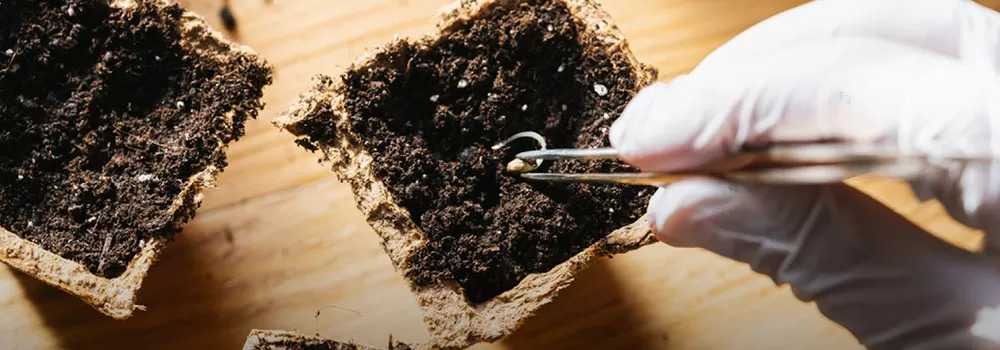
The selection of an appropriate location is paramount for the triumph of indoor cannabis cultivation. A favorable location should offer access to electricity, proper ventilation, and a consistent temperature and humidity range. The location should also be secure and private, ensuring it remains secluded from unwanted attention or odors. An optimal site can be a spare room, a closet, a tent, or any other suitable indoor space that fulfills these prerequisites.
Don’t know where to place your plants? Click here for more information about choosing the right location
Lighting
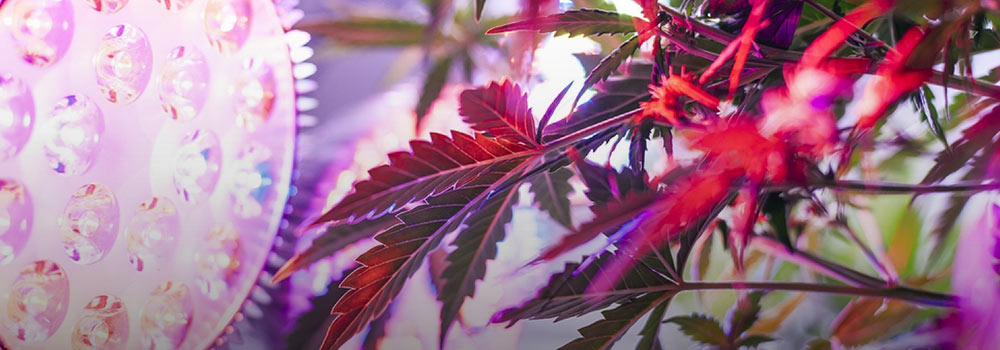
Knowing what kind of grow lights you need is crucial when growing cannabis indoors because it is the primary energy source for plant growth and plays a significant role in the plant’s overall development. Here are some important points to consider about indoor cannabis growing lights:
Indoor cannabis plants need the right light to grow and produce high-quality buds.
The type and intensity of light can influence the plant’s growth, yield, and potency.
Different growing stages require different lighting spectrums and intensities.
Matching the lighting system with the growing area’s size and ventilation capacity is essential to avoid heat buildup and other issues.
Several indoor growing lights are available, including
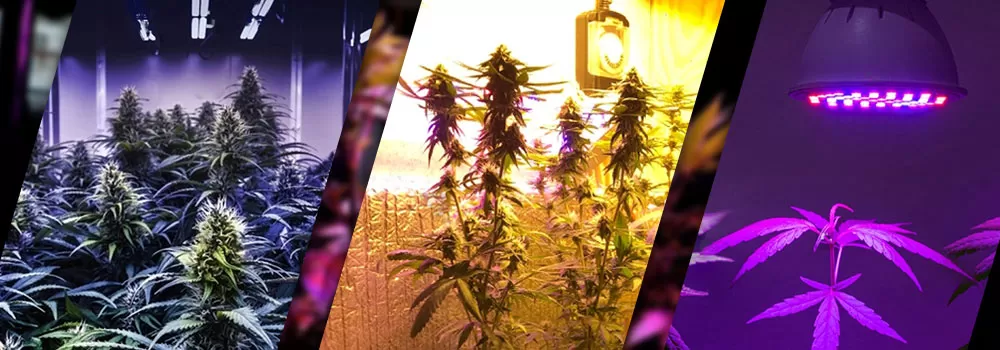
Fluorescent lights are efficient and affordable for small-scale growing but must be more powerful for larger yields.
High-Intensity Discharge (HID) lights high-output and energy-efficient lights suitable for large-scale growing.
LED lights are the most energy-efficient and versatile option, with adjustable spectrums for different growth stages.
Read the Complete Comparisons of These Grow Lights
Ventilation
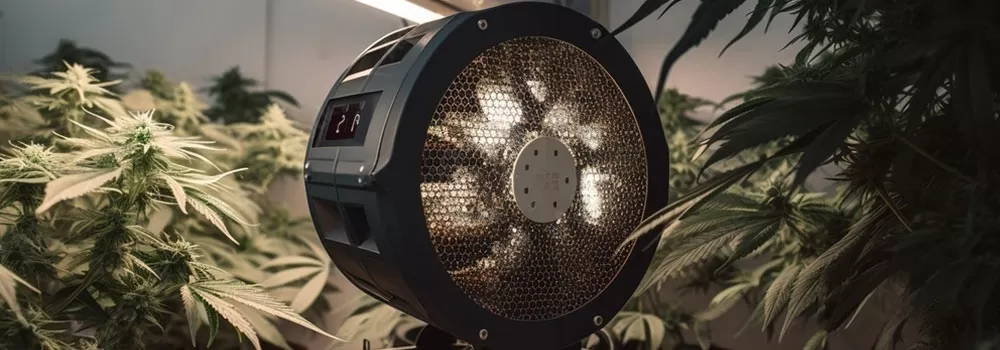
Ventilation is a crucial aspect of indoor cannabis growing because it ensures that your plants have access to fresh air and optimal levels of CO2. Proper ventilation can help maintain the health of your plants, prevent the buildup of excess moisture, and minimize the risk of pests and diseases. Here are some reasons why ventilation is important in indoor cannabis growing:
Regulates Temperature: Ventilation helps regulate temperature levels in your grow space by removing heat and preventing overheating, which can damage plants.
Removes Humidity: Good ventilation removes excess humidity, which can lead to mold and mildew growth on plants and in the grow space. Proper ventilation helps maintain the ideal humidity level, around 50-60%.
Provides Fresh Air: Plants need fresh air to thrive, and proper ventilation ensures they get enough oxygen and CO2. CO2 is essential for plant growth, and proper ventilation helps ensure that your plants have access to enough of it.
Prevents Pests and Diseases: Good ventilation can help prevent pests and diseases from taking hold in your grow space by circulating the air and preventing stagnant conditions where pests and diseases can thrive.
Improves Yield: Proper ventilation can help improve your plant’s yield by promoting healthy growth and preventing conditions that can lead to stunted growth, such as excess heat and humidity.
Different ways to ensure proper indoor grow space ventilation include fans, intake and exhaust systems, and air conditioning units. It’s important to ensure that the airflow is directed toward the plants and that the fans are placed strategically to ensure proper circulation.
Growing Medium
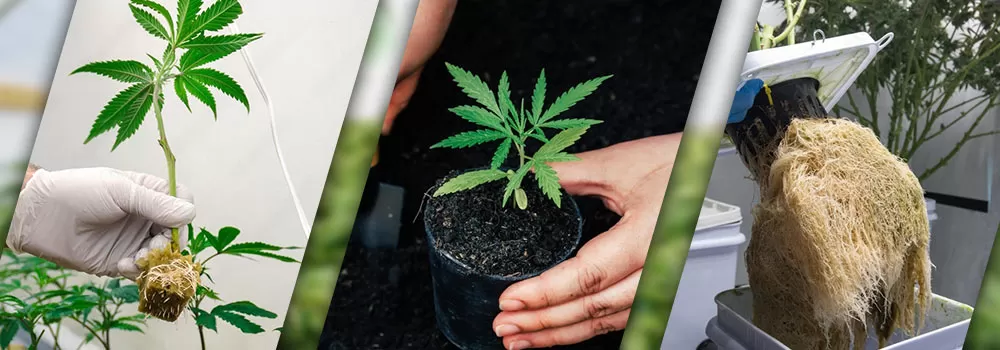
The marijuana growing medium is an essential component of indoor cannabis cultivation. It is the material in which the plant’s roots grow and obtain nutrients and support. There are several growing mediums available for indoor cannabis growers, and each one has its pros and cons.
Soil: Soil is the most commonly used growing medium for cannabis cultivation. It is easy to use, affordable, and readily available. Soil contains all the necessary nutrients for the plant to grow and retains water well. The downside to using soil is that it can be prone to pests, diseases, and pH imbalances, which can negatively affect plant growth.
Soilless: To achieve faster growth and bigger yields when growing cannabis, soilless growing using inert mediums like coco coir, perlite, and vermiculite is becoming increasingly popular. In soilless growing, the plants are hand-watered with nutrient-rich water instead of relying on the nutrients present in the soil. However, soilless growing does not have the same “buffer” as soil, which contains its own nutrients.
Hydroponics: Hydroponics is a soil-less growing medium that uses water and nutrients to feed the plant’s roots directly. It is a highly efficient growing method that allows for precise control of nutrient intake, resulting in faster growth and higher yields. The downside to using hydroponics is that it can be more expensive to set up and requires more maintenance than soil-based growing.
Know more in detail about the different types of growing mediums here!
After securing all the basics, we shall proceed to the first stage of growing cannabis seeds, the germination phase.
Germinating Cannabis Seeds
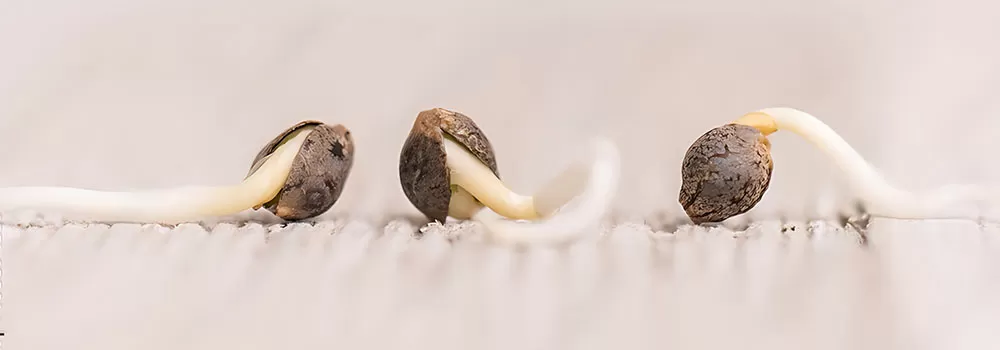
The germination of cannabis seeds is awakening a dormant seed and initiating its growth into a new cannabis plant. This essential step involves creating an ideal environment with adequate moisture, warmth, and oxygen to stimulate seedling emergence. Successful germination establishes the foundation for the plant’s entire lifecycle, ensuring its optimal growth and development.
Here is a trusted detailed step-by-step guide to fully germinating your cannabis seeds
Also, there are multiple methods of germinating seeds, and there is no right way of germinating these seeds, so here are some of those ways:
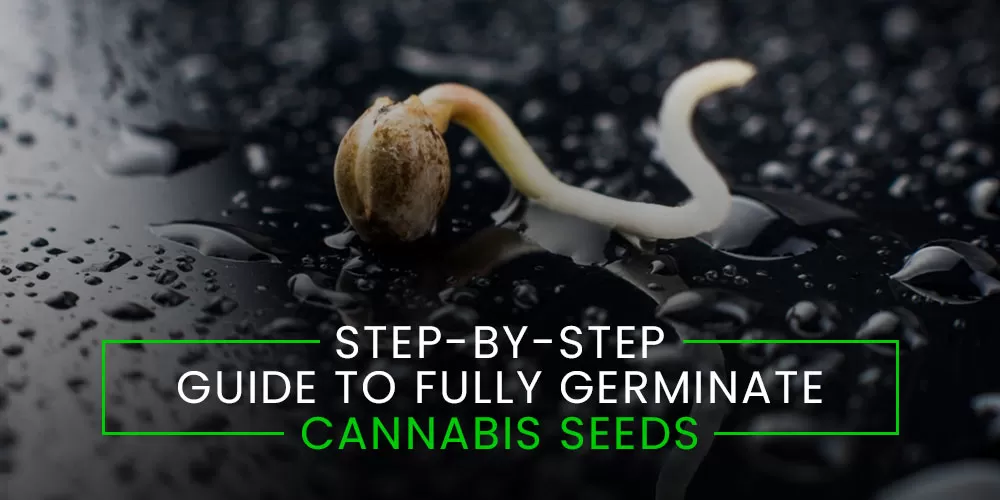
Soaking: Soaking cannabis seeds in water until they sink to the bottom is a common germination method. This can take anywhere from 12-24 hours.
The paper towel method involves placing seeds between damp paper towels and keeping them in a warm, dark place until they sprout. This usually takes 2-5 days.
Direct planting: Some growers skip the germination process and simply plant the seeds directly into the growing medium.
Jiffy pellet: A jiffy pellet is a small, compressed disc of peat moss that expands when soaked in water. Cannabis seeds can be planted directly into the center of the jiffy pellet.
Rockwool cubes: Rockwool is a popular growing medium made of spun mineral fibers. Seeds can be planted directly into pre-soaked rock wool cubes.
Each of these methods has its advantages and disadvantages, and the best method for germinating cannabis seeds will depend on the grower’s personal preferences and circumstances. But we have also recommended our guide here for an 80% guarantee of germination success.
Different types of germinating methods which is the one you like most
After successfully germinating your cannabis seeds, we will now determine the life cycles of a cannabis plant and how you will properly take care of these plants in these stages of their lifetime.
Vegetative and Flowering Stage: The Two Stages of Cannabis
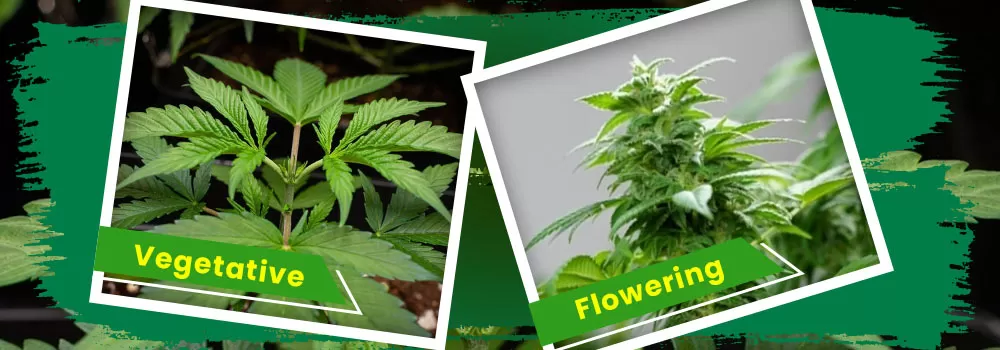
Vegetative Stage
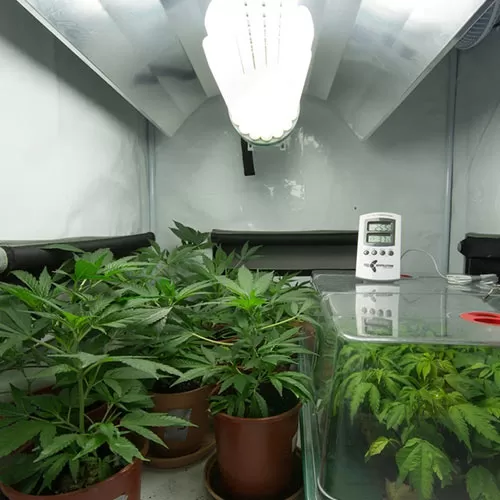
The vegetative stage is when the plant grows its leaves and stems, while the flowering stage develops buds. These stages are important because they require different light cycles, nutrients, and care for the plant to grow properly. During the vegetative stage, the plant needs a longer period of light (18-24 hours) and nitrogen-rich nutrients to encourage leaf and stem growth.
Here are the notable things about the vegetative stages of cannabis:
Light Schedule
Nutrients and Fertilizer
Watering
Training and Pruning
Lighting schedule
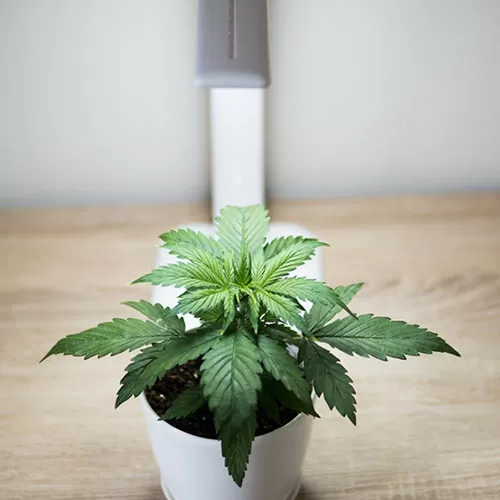
During the vegetative stage, cannabis plants require much light to grow and develop properly. Generally, growers use an 18/6 or 24/0 light schedule during the vegetative stage, providing 18 or 24 hours of light and 6 or 0 hours of darkness daily.
The 18/6 light schedule is more commonly used as it allows the plant to rest briefly each day, which is important for its overall health. Providing 24 hours of light can sometimes cause the plant to become stressed, leading to reduced yields and other issues.
When setting up a light schedule during the vegetative stage, it’s important to use a timer to ensure that the plants receive consistent light cycles. It’s also important to monitor the intensity of the light, which can be adjusted as the plants grow and develop.
One thing to remember is that different strains may have different light requirements during the vegetative stage. Some strains may require more or less light than others, so it’s important to research the specific strain being grown and adjust the light schedule accordingly.
Nutrients and Fertilizers
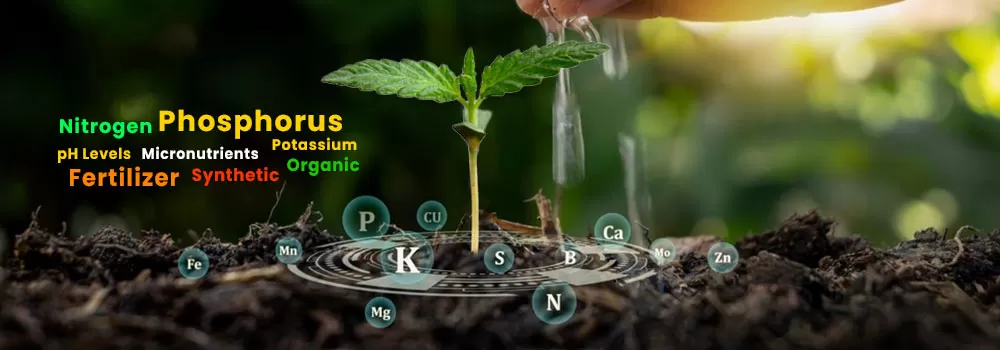
During the vegetative stage, cannabis plants require a specific balance of nutrients and fertilizers to support healthy growth. Here are some key factors to consider:
Nitrogen: During the vegetative stage, cannabis plants need more nitrogen than other nutrients. Nitrogen is responsible for leaf and stems growth, as well as the production of chlorophyll, which is essential for photosynthesis. Look for fertilizers that have a high nitrogen content.
Phosphorus and Potassium: While not needed in as high amounts as nitrogen, phosphorus and potassium are still important for vegetative growth. They help with root development and overall plant health. Look for fertilizers with a balanced ratio of phosphorus and potassium.
Micronutrients: Cannabis plants also require magnesium, calcium, and iron. These nutrients are needed in smaller amounts but are still important for healthy plant growth.
pH Levels: Maintaining proper pH levels in the soil or growing medium is essential to ensure nutrient uptake. During the vegetative stage, aim for a pH level between 6.0-7.0.
Organic vs. Synthetic: Growers can choose between organic or synthetic nutrients. Organic nutrients are derived from natural sources and provide a natural taste to the final product. Synthetic nutrients are artificially made and often cheaper but can yield higher yields.
Fertilizer Schedule: Following a fertilizer schedule and adjusting the amounts based on the plant’s needs is important. Typically, cannabis plants require fertilization every other watering, but it’s best to refer to the specific fertilizer’s instructions.
Watering
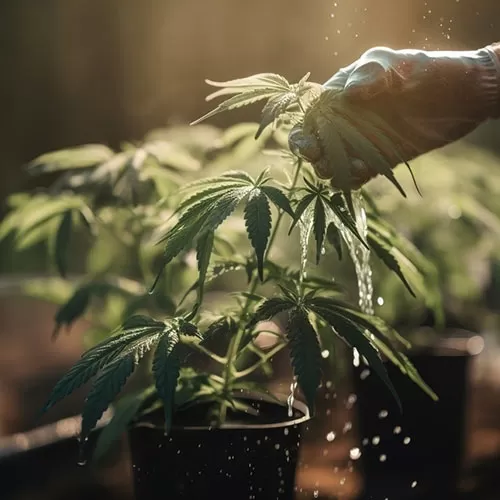
Proper cannabis watering during the vegetative stage of cannabis plants is essential for healthy growth and development. During this stage, the plant is focused on producing leaves and stems, so it requires plenty of water to support its growth. However, overwatering can lead to root rot and other problems, while underwatering can cause the plant to become stressed and reduce yields.
The general rule for watering cannabis plants during the vegetative stage is to wait until the top inch of the soil is dry before watering cannabis again. This allows the plant to absorb water and nutrients without becoming waterlogged or stressed. It’s important to avoid letting the soil become completely dry, as this can cause the plant to wilt and become stunted.
When watering, it’s important to use pH-balanced water free from chlorine and other harmful chemicals. A pH range of 6.0-7.0 is ideal for cannabis plants during the vegetative stage, as it allows optimal nutrient uptake. Watering should be done slowly and evenly, making sure to saturate the entire root system.
It’s also important to provide good drainage to prevent water from accumulating in the bottom of the pot, which can lead to root rot. This can be achieved by using pots with drainage holes, adding a layer of gravel at the bottom of the pot, or using a well-draining soil mix.
Training and Pruning
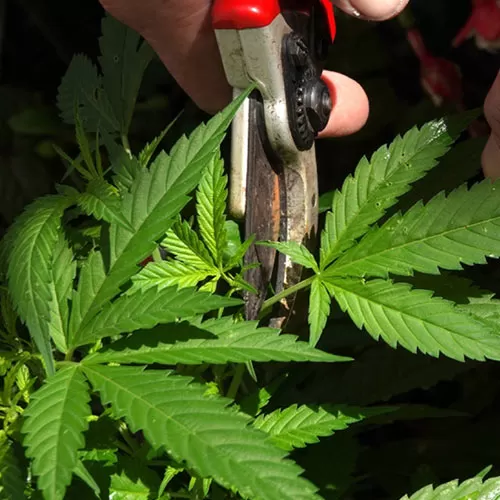
During the vegetative stage of cannabis, training and prune the plants to ensure optimal growth and yield is essential. Here are some common techniques used for training and pruning during the vegetative stage:
Topping: This involves cutting off the top of the main stem, which results in the growth of two new stems. This technique can help promote bushier growth and increase yields.
FIMing: Similar to topping, FIMing involves removing part of the main stem, but only the top growth tip is removed. This results in multiple new growth tips.
LST (Low-Stress Training): This technique involves bending and tying down the plant branches to encourage horizontal growth. This technique helps to create a more even canopy and increases light penetration.
HST (High-Stress Training): This technique involves more aggressive bending and tying down of branches, which can create more bud sites and increase yields. However, it can also be more stressful for the plant and requires careful monitoring.
Defoliation involves removing leaves from the plant to increase light penetration and airflow. It can also help to control pests and diseases.
When training and pruning cannabis plants during the vegetative stage, it is important to be gentle and avoid causing any damage or stress to the plant. Monitoring the plants closely and adjusting the training and pruning techniques to promote optimal growth and yield is also important.
Flowering Stage
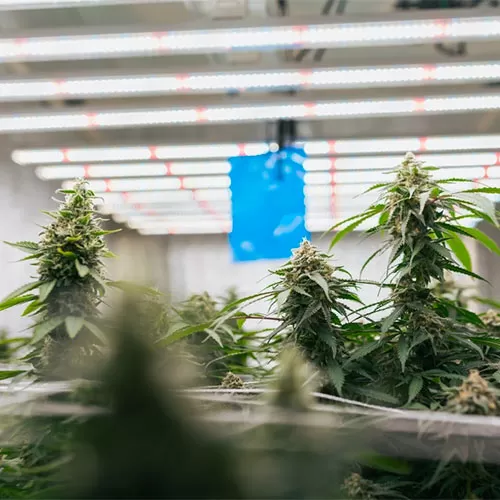
During the flowering stage, the plant requires a shorter period of light (12 hours) and phosphorus-rich nutrients to promote bud development. Properly managing these stages is crucial for successful indoor cannabis growth. We will discuss in detail what you must do in these stages.
Here are the notable things about the vegetative stages of cannabis:
Light Schedule
Nutrients and Fertilizer
Watering
Training and Pruning
Lighting schedule
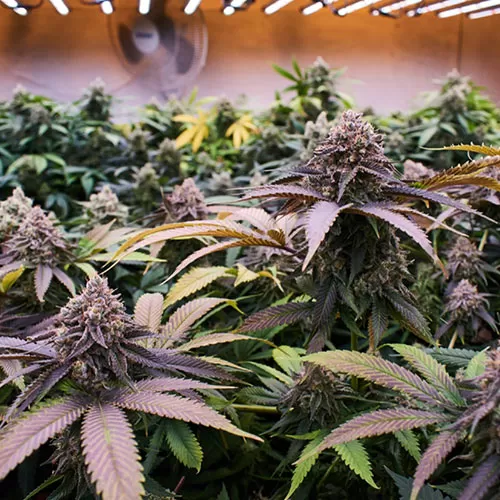
During the flowering stage of cannabis plants, a proper cannabis lighting schedule is crucial for the successful growth and development of the plants. Generally, cannabis plants require 12 hours of uninterrupted darkness and 12 hours of bright light during the flowering stage. This light cycle is known as a 12/12 photoperiod, miming the natural conditions the plant would experience during the fall season.
To maintain a 12/12 photoperiod, growers can use a timer to turn the lights on and off at specific times. The lights used during the flowering stage should be high quality and provide enough intensity and spectrum to support healthy growth and high yields. High-pressure sodium (HPS) lights or light-emitting diode (LED) lights with a spectrum rich in red and orange light are ideal for the flowering stage.
During the first two weeks of the flowering stage, it’s recommended to use a light cycle of 16 hours of light and 8 hours of darkness. This will help the plant to transition from the vegetative stage to the flowering stage without causing undue stress. After two weeks, the lighting schedule should be changed to the 12/12 photoperiod to initiate the flowering process.
It’s important to note that during the flowering stage, cannabis plants are very sensitive to light interruptions, which can cause stress and reduce yields. Therefore, it’s essential to maintain a consistent lighting schedule and avoid any interruptions during the dark cycle. Additionally, excessive light heat can also stress the plants, so growers should ensure that the temperature in the grow room remains within the optimal range for cannabis plants.
Nutrients and fertilizers
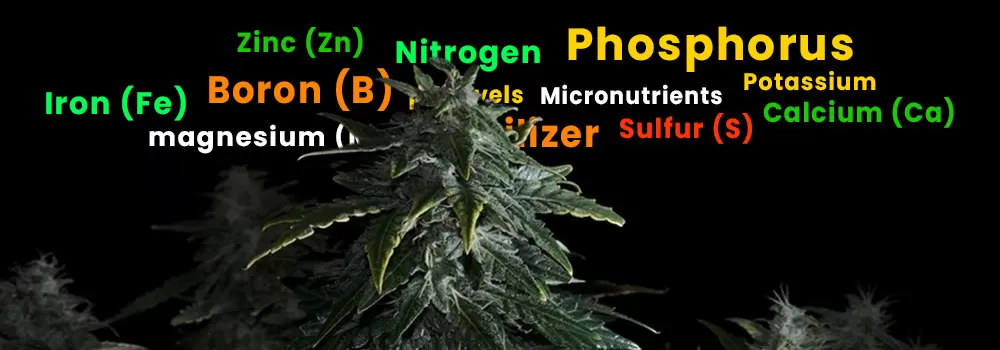
During the flowering stage, cannabis plants require a specific balance of nutrients and fertilizers to support healthy growth. Here are some key factors to consider:
Nitrogen (N) levels should be reduced during the flowering stage as the plant requires less of it at this stage. High nitrogen levels can cause the plant to produce more leaves than buds, so using a fertilizer with a lower nitrogen content is important.
Phosphorus (P) and potassium (K) are the primary macronutrients required during flowering. These nutrients play a crucial role in developing flowers and fruits, and a deficiency can cause reduced yields and lower-quality buds.
Calcium (Ca) and magnesium (Mg) are also important during the flowering stage as they are required for proper cell division and enzyme activity. A deficiency can cause stunted growth and leaf discoloration.
Sulfur (S) is another micronutrient essential for healthy plant growth during the flowering stage. It is required to produce certain amino acids and proteins necessary for bud development.
Micronutrients such as iron (Fe), boron (B), and zinc (Zn) are also important during the flowering stage, but they should be used sparingly as too much can cause toxicity.
It’s important to choose a fertilizer specifically designed for the flowering stage of cannabis plants, as it will have the correct balance of nutrients required for optimal growth and yields. Organic fertilizers are also a good choice as they slow nutrient release and improve soil health.
Watering
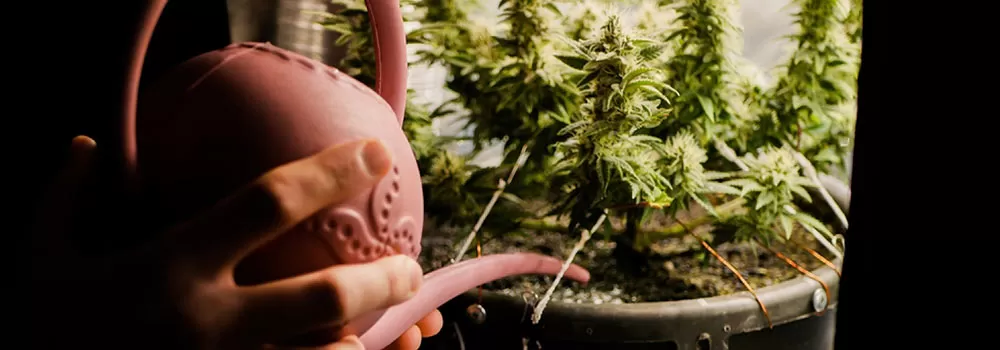
Proper watering cannabis during the flowering stage of cannabis plants is just as important as during the vegetative stage. However, the plant’s water requirements can change during this stage as it shifts its focus from producing leaves and stems to developing buds. Proper watering during the flowering stage can ensure optimal bud development and yields.
One of the most important factors to consider when watering cannabis plants during the flowering stage is the plant’s water intake. As the plant produces buds, its water requirements may increase, so it is important to monitor the soil moisture level and adjust watering accordingly. However, avoiding overwatering is also important, as this can lead to root rot and other issues.
The general rule for watering cannabis plants during the flowering stage is to water when the top inch of the soil is dry. However, it’s important to note that the plant’s water needs vary based on temperature, humidity, and pot size. It’s important to adjust the watering frequency accordingly and avoid letting the soil dry out completely.
When watering, it’s important to use pH-balanced water free from chlorine and other harmful chemicals. A pH range of 6.0-7.0 is ideal for cannabis plants during the flowering stage, allowing optimal nutrient uptake. It’s also important to avoid getting water on the buds, as this can lead to mold and other problems.
Training and pruning
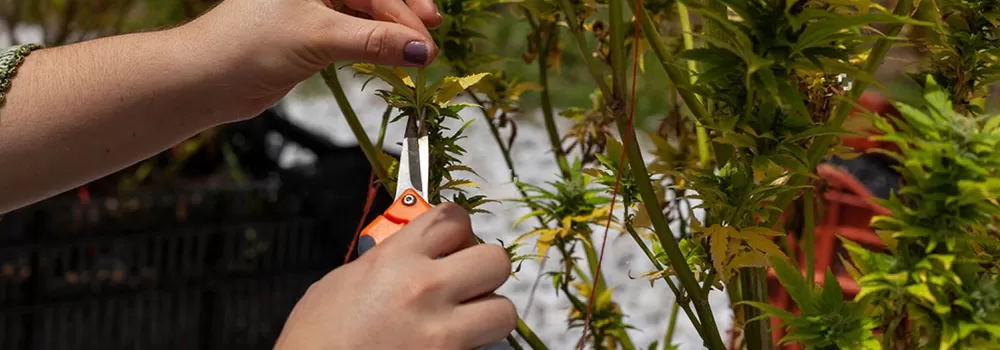
During the flowering stage, training and pruning techniques can help to increase yields and improve bud quality. Here are some proper techniques:
Low-Stress Training (LST): This involves gently bending and tying down the plant’s branches to create an even canopy and maximize light exposure to the buds.
Scrogging: Using a screen or net to create a horizontal canopy and evenly distribute the buds. This can increase yields and improve bud quality.
Topping: This involves cutting off the top of the main stem to encourage the growth of multiple colas. This can result in larger yields and a more even canopy.
Defoliation involves removing some of the plant’s fan leaves to increase light penetration to the buds and improve airflow. This can help prevent mold and increase yields.
Removing Suckers: Removing small branches or shoots that grow from the main stem or branches. This can redirect the plant’s energy to the main buds and improve overall quality.
It’s important to note that training and pruning techniques should be done carefully during the flowering stage, as any stress on the plant can impact bud development. It’s also important to prune sparingly, as this can lead to a decrease in yield. Following these techniques can help to improve the overall quality of the plant’s buds and increase yields.
Want to properly train your cannabis plants? Click here!
Harvesting Cannabis

Harvesting cannabis is the final step in the cultivation process that requires proper techniques and timing to ensure optimal yield and potency. That is why it is important to do it properly and precisely, so here is a step-by-step guide for you to follow when harvesting your yields.
1. Determine the right time to harvest
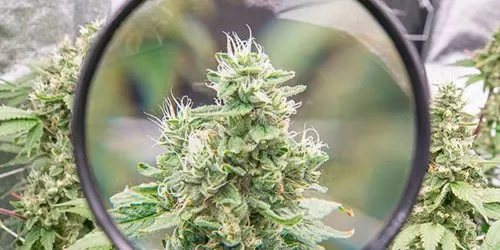
The ideal time to harvest cannabis depends on the strain, growing conditions, and desired effect. Generally, cannabis plants are harvested when the buds reach their peak maturity, indicated by the color of the trichomes (the tiny crystal-like structures on the buds). Look for milky white trichomes with amber or brown tips, indicating that the THC content is at its highest.
2. Stop fertilizing and flushing
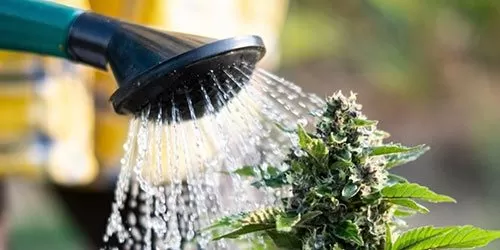
Stop fertilizing your plants at least two weeks before harvest to allow them to use up any excess nutrients and minimize the risk of chemical residues in the final product. Flush your plants with clean water for at least one week before harvesting to remove any remaining nutrients and improve the taste and quality of the buds.
3. Prepare the tools and equipment
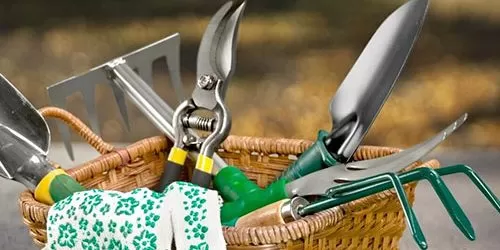
Gather the necessary tools and equipment, such as gloves, scissors, pruning shears, drying racks, and storage containers. Clean and sterilize your tools to prevent the sprea of pests or diseases.
4. Cut the plants
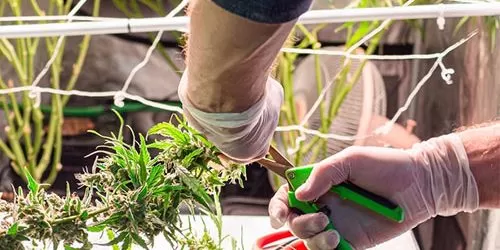
Cut the main stem at the base with pruning shears or a sharp knife. Alternatively, you can cut the branches individually if you prefer to hang them upside down for drying. Handle the plants gently to avoid damaging the buds and trichomes.
5. Trim the buds
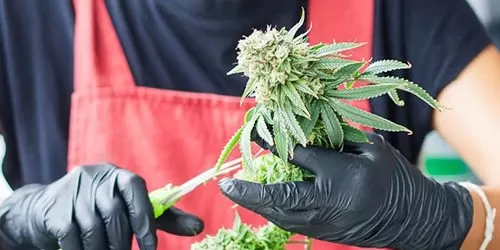
Remove the large fan leaves and excess foliage from the buds with scissors or pruning shears. Leave some leaf material around the buds to protect them during drying and curing.
6. Drying Weed
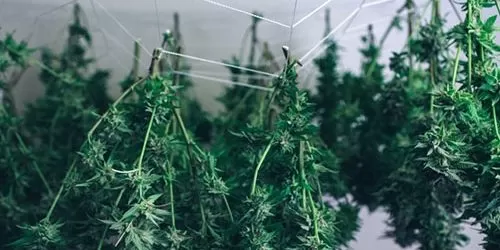
Turn the trimmed buds upside down on drying racks in a dark, cool, and well-ventilated area. Keep the temperature and humidity levels consistent, ideally around 60-70°F and 50-60% humidity. Allow the buds to dry for 7-10 days or until the stems snap instead of bend.
7. Curing Weed
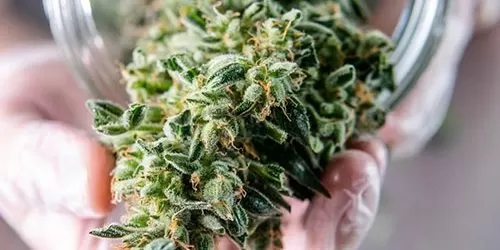
Once they are dry, place them in glass jars or airtight containers for curing. Open the jars for a few minutes daily to allow fresh air circulation and release excess moisture. Cure the buds for at least two weeks, preferably longer, up to several months, to enhance their flavor, aroma, and potency.
8. Store the buds
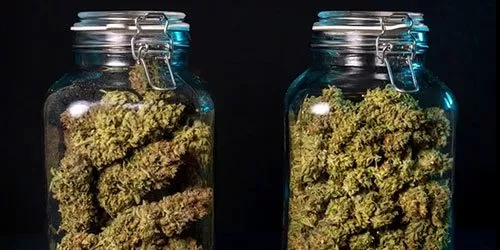
Once the buds are fully cured, store them in a cool, dark, and dry place, away from light and heat sources. Use airtight containers or vacuum-sealed bags to prevent exposure to air and moisture.
So, we have already discussed all you need to know in growing cannabis, whether indoors or outdoors following all the tips and information above will guide you to the success of becoming a full-fledged cannabis cultivator. Now, we will go into the most common issues in growing cannabis so that you can avoid this and will always be successful in your harvests.
Common Issues in Growing Cannabis
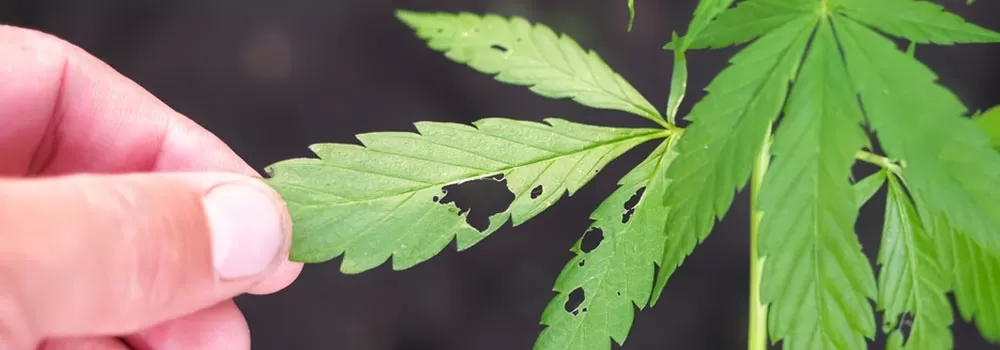
Growing cannabis can be a rewarding experience, but it also comes with its share of challenges. The three main issues that cannabis growers commonly face are pest and disease infestations, nutrient deficiencies, and environmental factors. These problems can significantly impact the growth, yield, and quality of cannabis plants, and addressing them requires knowledge, skills, and proper management techniques. Understanding how to prevent, identify, and treat these issues is essential for successful cannabis cultivation.
Pests and Diseases
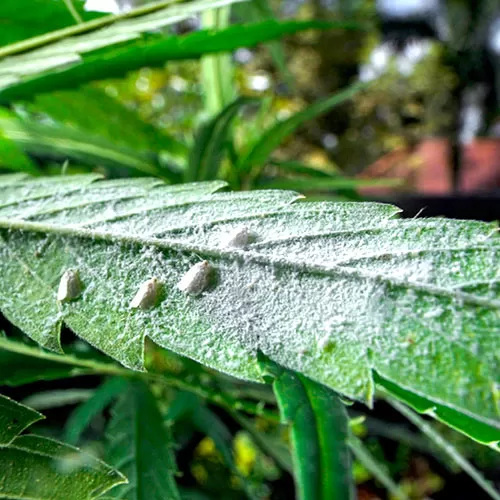
The impact of common cannabis pests and diseases on cannabis cultivation can be significant since they can harm the plants, decrease their yield, and result in crop failure. Pests like thrips, spider mites, and aphids can feed on the plant’s leaves and sap, weakening the plant’s overall health and causing damage. Likewise, diseases such as bud rot, powdery mildew, and root rot can reduce yield, weaken the plant, and even kill it.
Moreover, pests and diseases can make the plants more vulnerable to other issues besides the direct damage they cause. For instance, plants weakened by pests or diseases might be more prone to environmental stresses like drought, temperature changes, and nutrient deficiencies. This can lead to further damage and decreased yields, so we must know the most common pests and diseases.
Nutrient Deficiencies
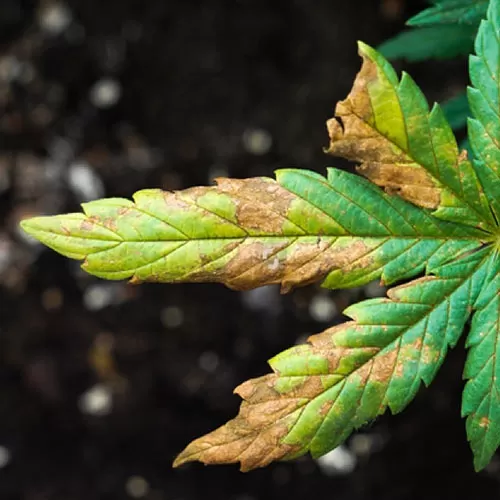
Cannabis plants require a range of essential nutrients to grow and develop properly, including macronutrients such as nitrogen, phosphorus, and potassium and micronutrients such as calcium, magnesium, iron, and others. A deficiency of any of these nutrients can lead to various symptoms affecting the plant’s growth, health, and potency.
One of the most common cannabis nutrient deficiencies in cannabis cultivation is Potassium deficiency, which can cause the yellowing or browning of leaves, weakened stems, and reduced bud size and quality. To treat this deficiency, growers can add potassium-rich fertilizers such as potassium sulfate or wood ashes to the soil or hydroponic solution.
Calcium deficiency can result in curled or distorted leaves, weak stems, and reduced bud production. To treat this deficiency, growers can add calcium-rich fertilizers such as calcium nitrate or gypsum to the soil or hydroponic solution.
Magnesium deficiency can lead to the yellowing of leaves, especially in the lower parts of the plant, as well as stunted growth and reduced yields. To treat this deficiency, growers can add magnesium-rich fertilizers such as Epsom salt or dolomite lime to the soil or hydroponic solution.
Other nutrient deficiencies that can affect cannabis plants include iron, sulfur, zinc, and manganese deficiencies. Symptoms of these deficiencies can include the yellowing of leaves, stunted growth, and reduced yield. To treat these deficiencies, growers can use specialized fertilizers or supplements that contain the missing nutrients.
Nutrient deficiencies can significantly impact the health and growth of cannabis plants. By understanding these deficiencies’ symptoms, taking appropriate treatment measures, and knowing the right pH level to prevent nutrient deficiency, growers can ensure that their plants receive the essential nutrients they need to thrive and produce high-quality buds.
Learn more about Preventing Cannabis Nutrient Deficiencies
Environmental Factors
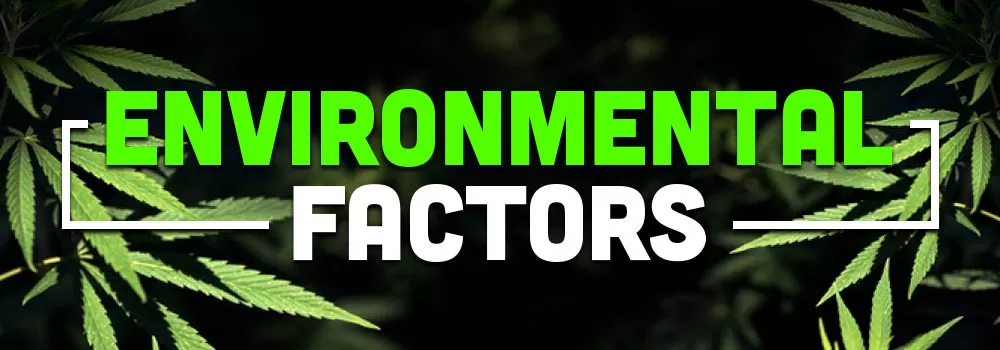
Cannabis cultivation requires attention to various environmental factors to ensure healthy growth and high-quality yields. Three of the most critical environmental factors affecting cannabis cultivation are light burn, heat stress, and cold stress.
Light burn
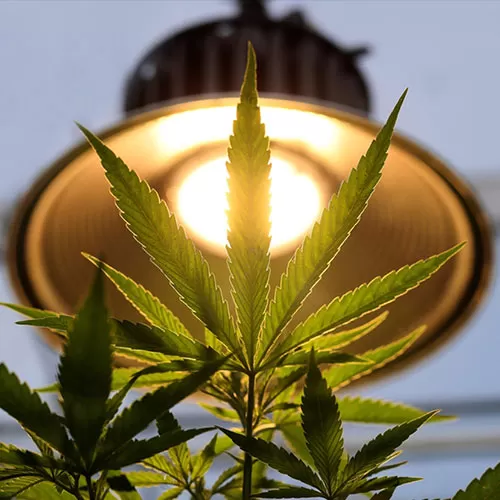
is common in indoor cannabis cultivation, particularly with high-intensity lighting systems such as HPS or LED. When cannabis plants are exposed to too much light intensity for an extended period, it can lead to leaf burn and plant damage. Symptoms of light burn include bleached or burnt leaves, with the burnt area appearing as a yellow or white spot. To prevent a light burn, growers can reduce the intensity of the light source, increase the distance between the light source and plants, or use reflective surfaces to diffuse the light.
Heat stress
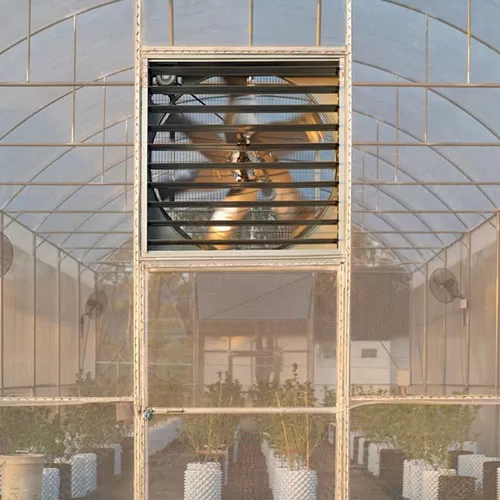
is another environmental factor that can negatively impact cannabis cultivation.
Cannabis plants thrive in temperatures between 20-30°C (68-86°F). However, temperatures above 30°C (86°F) can cause heat stress, reducing growth, wilting, and even plant death. To avoid heat stress, growers can use temperature control systems such as ventilation, air conditioning, and humidity control. They can also choose strains more resistant to high temperatures or cultivated during cooler months.
Cold stress
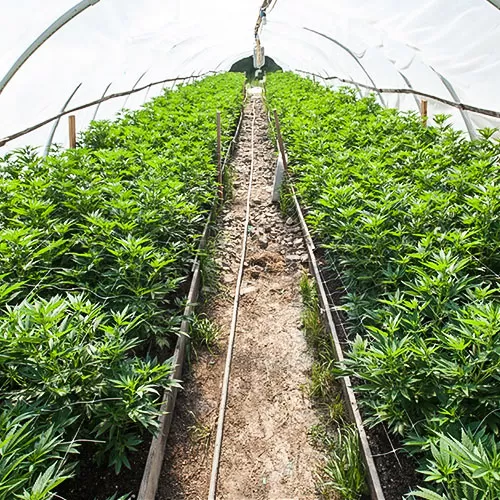
is a particular concern for outdoor cannabis cultivation. When temperatures drop below 15°C (59°F), cannabis plants can experience cold stress, leading to slower growth, reduced yields, and potential damage to the plant’s tissue. Symptoms of cold stress include yellowing or browning of leaves and slow growth. To prevent cold stress, growers can use greenhouse structures to control the temperature or select strains more resistant to colder climates. To create the perfect growing environment, you must always consider all these factors.





